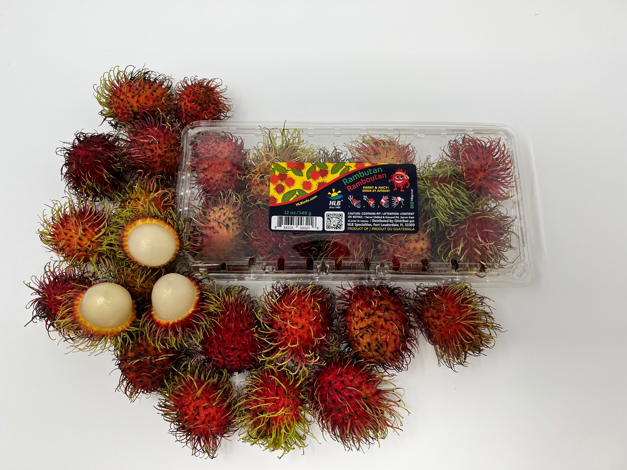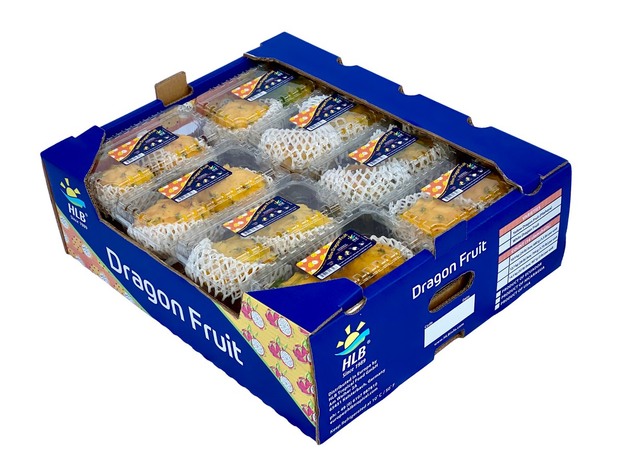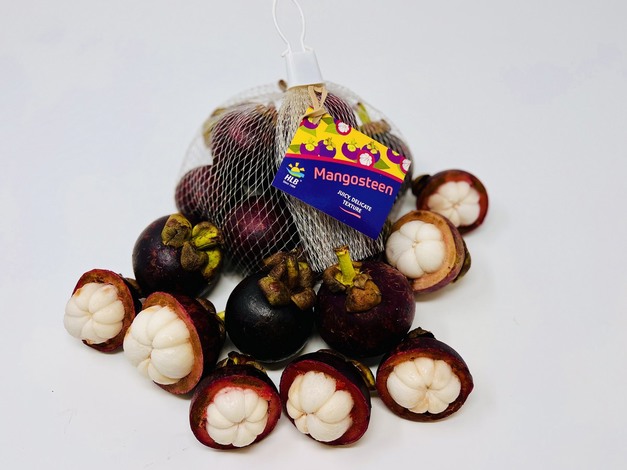 Most exotic produce items are in season currently. “We offer both conventional and organic exotics,” says Melissa Hartmann de Barros, Director of Communications at HLB Specialties. Within the organic segment, the company offers papayas, yellow dragon fruit, red dragon fruit, rambutan, and ginger. When visiting the Organic Produce Summit last week, Hartmann de Barros noticed that the selection of organic exotics at the show was fairly limited. “I just saw organic dragon fruit on display, but I didn’t see many niche exotics. It confirmed that we are a trendsetter with our organic exotics and on the right track,” she said.
Most exotic produce items are in season currently. “We offer both conventional and organic exotics,” says Melissa Hartmann de Barros, Director of Communications at HLB Specialties. Within the organic segment, the company offers papayas, yellow dragon fruit, red dragon fruit, rambutan, and ginger. When visiting the Organic Produce Summit last week, Hartmann de Barros noticed that the selection of organic exotics at the show was fairly limited. “I just saw organic dragon fruit on display, but I didn’t see many niche exotics. It confirmed that we are a trendsetter with our organic exotics and on the right track,” she said.
HLB Specialties has been expanding their selection of conventional and organic exotics in recent years. “Our retail partners keep challenging us to come up with new items. At the moment, we are working on the final packaging design of a new item that will be rolled out late summer.”
 Rambutan.
Rambutan.
Rambutan Rambutan is one of HLB’s key items. The Guatemalan season started late June after a delay due to weather. “It was a full six-week delay compared to our earliest ever start,” said Andres Ocampo, CEO of HLB Specialties. In the meantime, volumes have picked up and the season is expected to last throughout the year. Demand is also starting to pick up now that the lychee season is winding down. “Since lychee and rambutan show some similarities, some retailers don’t like to carry them simultaneously. Due to limited shelf space, they bring in rambutan as soon as the lychee season has finalized.” While rambutan is available at US retailers right now, HLB anticipates availability to increase starting the first week of August. “The lychee season is expected to end in the next couple weeks and retailers will fully transition into rambutan.”
Rambutan is one of HLB’s key items. The Guatemalan season started late June after a delay due to weather. “It was a full six-week delay compared to our earliest ever start,” said Andres Ocampo, CEO of HLB Specialties. In the meantime, volumes have picked up and the season is expected to last throughout the year. Demand is also starting to pick up now that the lychee season is winding down. “Since lychee and rambutan show some similarities, some retailers don’t like to carry them simultaneously. Due to limited shelf space, they bring in rambutan as soon as the lychee season has finalized.” While rambutan is available at US retailers right now, HLB anticipates availability to increase starting the first week of August. “The lychee season is expected to end in the next couple weeks and retailers will fully transition into rambutan.”
 Yellow dragon fruit.
Yellow dragon fruit.
Dragon fruit
White and red dragon fruit is offered from Florida as well as yellow, white, red and purple dragon fruit from Ecuador. Heavy rains have affected the production regions of dragon fruit in Florida and as a result, the season has started slowly. “We’ve seen more supply regularity in the past two weeks. All in all, the trees have been affected by the rain and the expectation is for volume to be lost due to the weather,” commented Ocampo.
Ecuador, the main dragon fruit supplier, is currently in a low-volume period with less frequent arrivals. “During this time of year, there is more time in-between arrivals as opposed to the November – May time frame when volumes are larger and arrivals more consistent,” said Ocampo. “Historically, starting in September, volumes and shipment frequencies should increase.”
“There is an abundance of cherries this season with prices as low as $1.50/lb at retail level. In addition, other stone fruits like peaches and nectarines as well as watermelon take away from dragon fruit shelf space. “We should see demand pick up again around October, when there is more space for imports.”
 Mangosteen.
Mangosteen.
Mangosteen
HLB is in its 6th season year of handling bringing in mangosteen from different countries, supplying clients in the US, Canada, and Europe, through its German sister company HLB Tropical Food GmbH. “It’s very much a niche exotic that is still gaining in exposure. Mangosteen crops don’t start producing until their 8th year, keeping the cost of the fruit high,” said Hartmann de Barros. “Consumers are starting to discover mangosteen, but we still have a long way to go on educating consumers and receivers on the retail side.”
She explained that mangosteen isn’t grown in the US and as a result, many people are not familiar with it. “Passionfruit for instance is well known among Hispanics, but mangosteen isn’t. In fact, the Southeast Asian population is more familiar with mangosteen than Hispanics. “This fruit is a perfect complement to our line, because it is a very tasty and exciting, healthy fruit. After the pandemic, consumer interest and demand remains high for these niche items, such as mangosteen.”
Guava
Guava is a relatively new item for HLB Specialties, but the company has been pleasantly surprised with the growth among their retail clients. HLB sources guavas year-round from Mexico and demand has been strong among consumers as well. “We get lots of calls and emails from final consumers, asking where to find our guava,” explained Hartmann de Barros. She has also seen a spike on social media of people using guava in their daily lives, such as juices and cocktails. “These posts are proof that we are on the right track with our exotic fruit selection and we look forward to a strong second half of the year.”
 For more information:
For more information:
Melissa Hartmann de Barros
HLB Specialties
Tel: (+1) 954-475-8808
Melissa@hlbspec.com
www.hlbspec.com
